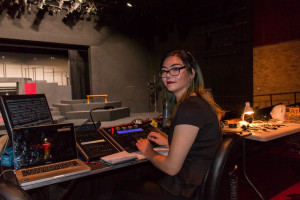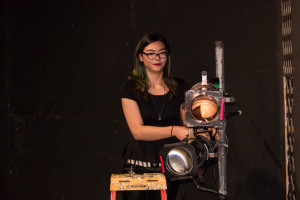Tags
Related Posts
Share This
Lighting the Way
Every performance needs lights. This statement is obvious as an audience needs to see, but it extends beyond that, as lights can be manipulated or utilized to set the scene in any area of the world or bring the mood to complete fruition. Lights play off the actors, the audience, the costumes and scenery, becoming one of the most essential aspects of a production. Those who learn to handle lighting with care and thought are often at the far sidelines of the action, working with quiet diligence.
Santa Fe University of Art and Design Performing Arts Department senior Annie Haynes is one of those, thriving in lighting’s blend of technical prowess and creativity. She carries herself with confidence, speaking strongly and shortly, occasionally punctuating her own reserved airs with a light laugh. Haynes just exited a stint as assistant lighting designer for Company, and will soon begin designing for Twelfth Night.

Senior Technical Theater Major Annie Haynes changing the lighting on stage. Photo by Yoana Medrano.
Jackalope Magazine: Did you start out as a lighting major? I mean, has this been your focus this entire time?
Annie Haynes: When I came in I was just a general tech major. I didn’t have a focus because in high school I did everything, so I wasn’t sure what I wanted to specialize in. But, after freshman year, lighting just kind of became what I wanted to do.
How many people in your department are currently pursuing lighting?
So there’s me, and there’s Kyra [Murzyn] who’s a junior, and that’s it I think. We’re the only upperclassmen.
How would you explain what you do to someone who maybe doesn’t understand?
(Laughs) Well, I mean, I light the show. A lot of people don’t ever really realize that the lighting is such an important part of a production. They don’t really pay attention to it. They pay more attention to the costumes and set because that’s what they know. I guess it makes more sense; it’s a tangible thing. But with lighting, it just changes everything.
So, what is usually the process if you’re working on a show? Like, from start to finish, what do you have to do to get to the final product?
It starts off with the script and reading through that, doing an analysis and breaking down where every scene is taking place and what world we’re in. Then, meeting with the director and the other designers, ‘cause theater is such a collaboration. Like, all the different designers and everyone’s ideas are creating a world where the show’s going to be. Going from there, we make decisions on lighting systems and colors and textures; we make the plot. There’s lots of paperwork and boring technical math things that people don’t want to hear about. Then, getting to the actual show is when the fun stuff happens. Tech week, building cues and going through the show. We finally get it happening.

Annie Haynes focusing the lighting on stage. She is a technical theater major with a specialization in lighting design. Photo by Yoana Medrano.
How did working on Company go for you?
I was the assistant lighting designer to a faculty lighting designer, and honestly I felt like I didn’t really do a lot! I would have liked to but different designers want different things from their assistants. Like, design wise I didn’t do much of anything, but I updated paperwork for him and ran the hang and focus calls on the plot, and I was in charge of the follow spots. I was their boss. (She laughs again)
Academically speaking, how is your track supported? What classes do you take and what do you focus on in your schoolwork?
So, in this department, there’s a toolbox class and then the upper level class for each thing. So, there’s stagecraft, and then scenic design, costume toolbox, costume design, and then a basic stage lighting class that I took freshman year, and a lighting design class that I took last year. Those are the only lighting classes. It’s mostly hands on work, like we take a class and then we’re in [Rehearsal and Production] almost every day actually practicing. Then, we get design assignments and we work on shows.
You’ll be graduating soon. What do you want to do with this?
I mostly want to go into concert lighting, stuff like festivals. I also really like designing for dance but it’s such a small industry now and there’s not a whole lot of opportunities, but that’s what I would want to do.
What would you say in terms of advice to someone who would like to start working on lighting but doesn’t really know what its all about?
I think the best thing to do is to just get involved. Even if you don’t know a lot you can learn, and there’s only so much you can learn from, like, reading a book or taking a class that is out of a book. I didn’t really understand it either until I had my hands on a lighting instrument and I found out how it worked and what to do with it. Going from there you obviously need to have training and knowledge of the various software and things and a class on design but if you just want to start working with lights you should just… start working with lights.
What has been your biggest challenge in this department for you so far?
In this specific program? We haven’t had student designers in awhile, and so I’m finally actually designing a show. I’ve just been people’s assistant, like, five times, and so this year student designers can finally happen! So, I get to design this semester, which is really exciting. I just wish it could have happened sooner, but when the new chair and faculty came in there was a lot of changes and I understand why there couldn’t be student designers in the past, so hopefully for the people coming in now, they’ll get design opportunities.
So, you’re designing Twelfth Night, tell me about that.
I’m so excited. Twelfth Night is – and I’m not the biggest fan of Shakespeare – Twelfth Night is my favorite Shakespeare play. It’s a good one, and it’s interesting to work with because there are a few student designers on the show, and also faculty designers, and the director. So, it’s weird working with my teachers in this collaborative team, but it’s pretty cool. I’m excited. I get to finally do something!
This interview has been edited for style and clarity.






 Jackalope Magazine is the student magazine of Santa Fe University of Art and Design. Building on the interdisciplinary nature of our education, we aim to showcase the talent of our university and character of our city.
Jackalope Magazine is the student magazine of Santa Fe University of Art and Design. Building on the interdisciplinary nature of our education, we aim to showcase the talent of our university and character of our city.
Recent Comments